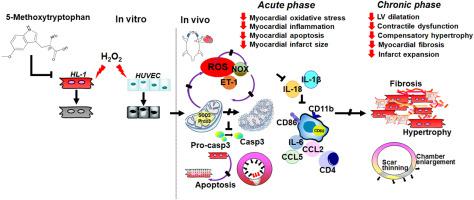Journal of Molecular and Cellular Cardiology ( IF 4.9 ) Pub Date : 2021-06-01 , DOI: 10.1016/j.yjmcc.2021.05.014 Wan-Tseng Hsu, Ya-Hsuan Tseng, Hsiang-Yiang Jui, Chen-Chin Kuo, Kenneth K. Wu, Chii-Ming Lee

|
Aims
Myocardial infarction (MI) remains a major cause of heart failure. 5-Methoxytryptophan (5-MTP), a 5-methoxyindole metabolite of L-tryptophan, exerts anti-inflammatory and antifibrotic effects, but MI impairs the biosynthesis of cardiac 5-MTP. Therefore, we evaluated the effect of exogenous 5-MTP administration on rescuing post-MI cardiac injury.
Methods and results
After a detailed pharmacokinetic analysis of 5-MTP, Sprague Dawley rats that had undergone left anterior descending coronary artery ligation received intraperitoneal administration of either 17 mg/kg 5-MTP or saline at 0.5 and 24 h after MI. Cardiac systolic function, infarction size, and fibrosis were evaluated using echocardiography, triphenyltetrazolium chloride staining, and Masson trichrome staining, respectively. Myocardial apoptosis was analyzed by staining for caspase-3 and cardiac troponin I. 5-MTP treatment decreased the infarct area and myocardial apoptosis; attenuated systolic dysfunction and left ventricular dilatation; and reduced cardiomyocyte hypertrophy, myocardial fibrosis, and infarct expansion. Crucially, 5-MTP alleviated oxidative stress by preserving mitochondrial antioxidant enzymes and downregulating reactive oxygen species–generating NADPH oxidase isoforms and endothelin-1. Consequently, 5-MTP-treated MI rat hearts exhibited lower levels of chemokines and cytokines, namely interleukin (IL)-1β, IL-18, IL-6, C-C motif chemokine ligand (CCL)-2, and CCL5, accompanied by reduced infiltration of CD11b+ cells and CD4+ T cells. Notably, 5-MTP protected against H2O2-induced damage in HL-1 cardiomyocytes and human umbilical vein endothelial cells in vitro.
Conclusion
5-MTP prevented post-MI cardiac injury by promoting mitochondrial stabilization and controlling redox imbalance. This cytoprotective effect ameliorated macrophage and T-cell infiltration, thus reducing the infarct size, attenuating fibrosis, and restoring myocardial function.
中文翻译:

5-甲氧基色氨酸通过控制氧化应激和免疫激活来减轻梗死后心脏损伤
目标
心肌梗塞 (MI) 仍然是心力衰竭的主要原因。5-甲氧基色氨酸 (5-MTP) 是 L-色氨酸的 5-甲氧基吲哚代谢物,具有抗炎和抗纤维化作用,但 MI 会损害心脏 5-MTP 的生物合成。因此,我们评估了外源性 5-MTP 给药对挽救 MI 后心脏损伤的作用。
方法和结果
在对 5-MTP 进行详细的药代动力学分析后,接受左冠状动脉前降支结扎的 Sprague Dawley 大鼠在 MI 后 0.5 和 24 小时腹膜内给予 17 mg/kg 5-MTP 或生理盐水。分别使用超声心动图、氯化三苯四唑染色和 Masson 三色染色评估心脏收缩功能、梗死面积和纤维化。通过 caspase-3 和心肌肌钙蛋白 I 染色分析心肌细胞凋亡。5-MTP 治疗减少了梗塞面积和心肌细胞凋亡;减轻收缩功能障碍和左心室扩张;并减少心肌细胞肥大、心肌纤维化和梗塞扩大。至关重要的是,5-MTP 通过保留线粒体抗氧化酶和下调活性氧物质(产生 NADPH 氧化酶亚型和内皮素-1)来缓解氧化应激。因此,5-MTP 处理的 MI 大鼠心脏表现出较低水平的趋化因子和细胞因子,即白细胞介素 (IL)-1β、IL-18、IL-6、CC 基序趋化因子配体 (CCL)-2 和 CCL5,伴随着减少CD11b 浸润+细胞和 CD4 + T 细胞。值得注意的是,5-MTP 在体外保护 HL-1 心肌细胞和人脐静脉内皮细胞免受 H 2 O 2诱导的损伤。
结论
5-MTP 通过促进线粒体稳定和控制氧化还原失衡来预防 MI 后心脏损伤。这种细胞保护作用改善了巨噬细胞和 T 细胞浸润,从而减少了梗死面积,减轻了纤维化,恢复了心肌功能。











































 京公网安备 11010802027423号
京公网安备 11010802027423号